|
|
|
 |
|
"SO WHEN YOU GIVE TO
THE NEEDY,
DON'T ANNOUNCE IT WITH TRUMPETS,
AS THE HYPOCRITES DO IN THE SYNAGOGUES"
MATTHEW 6:2
|
|
|
 |
|
 |
Seventeen times the word "hypocrites" appears in the
Gospels, and three times in
the Sermon on the Mount. Where would Jesus,
growing up in the small village of Nazareth, have
come into contact with “hypocrites,” a Greek word
for actors who wore masks, (thus having two faces)? Perhaps five miles away in Sepphoris.
Perched like a bird (tzippor in Hebrew) on a
Galilee hilltop, Sepphoris (Hebrew: Tzippori)
is an hour’s walk from Nazareth, Jesus’ hometown.
During Jesus’ childhood, Sepphoris was the
provincial capital of Galilee and the city where the
villagers took care of their official business.
It had a theater which seated about 3,000
spectators. |
| |
|
 |
|
Photo: Gila
Yudkin |
|
Partially reconstructed Roman
theater in Sepphoris |
| |
Bible scholar and
archeologist Jerome Murphy O’Connor believes that
after returning from Egypt, Joseph and Mary settled
in Nazareth precisely because of its proximity to
Sepphoris. After 3 BC, Sepphoris was the
center of a building boom, providing work
opportunities for artisans such as Joseph.
Did Jesus have a hand building the theater of
Sepphoris, just reconstructed for us? Perhaps.
Could he have been a spectator here to a tragedy,
comedy or farce? Jesus was an observant Jew and followed
the precepts of the rabbis for whom the theater
represented a way of life that was external,
hedonistic and above all, pagan. Yet
undoubtedly Jesus knew what went on a theater.
Rabbi Levi said: “There are six things which serve
man; three are in his control, and three are not.
Eye, nose and ear are not. He must see, smell
and hear what he may not want to see, smell and
hear. A man may be passing through a street
when they are burning incense to an idol, and he has
no wish to smell the incense, but his nose forces
him to do so. So, too, his eye brings him
sinful sights, and his ear blasphemous words,
against his will, for they too are not under his
control.
But mouth, hand and foot are in his power. He
need not desire with his mouth to labor in the Law.
He need not wish to slander or curse or blaspheme.
He need not wish with his hand to fulfill the
commandments. He need not wish to steal or
murder. With his foot he can visit theatres
or circuses, or he can go to the synagogues or
houses of study.” (Tanhuma edited by Martin
Buber)
What we do know, is that when Jesus used the image
of “hypocrite” to criticize the religious leaders
for their exaggerated public display of piety, his
message reverberated loudly and clearly throughout
Galilee. |
| |
|
 |
|
Copyright
2012 by Gila Yudkin |
|
Map of Galilee -- towns and
villages in Jesus' day |
| |
| After visiting the
theater at Sepphoris, we discover that the city was
an artisan’s paradise, not only for carpenters and
masons, but for mosaic designers as well. Walking
through the ruins, we come across brilliantly
preserved mosaic floors illustrating pagan themes of
wine, women and the wheel of the zodiac.
|
| |
|
 |
|
Photo: Mike
Clark |
|
The wheel of the Zodiac in the
Sepphoris synagogue |
| |
|
Even the synagogue, discovered in 1993, had a
floor mosaic picturing the chariot of Helios, Greek
god of the sun, surrounded by the twelve
astrological signs of the zodiac. And this was
no “new age” synagogue. One of the congregants
may have been none other than the Chief Rabbi
himself. (During the second and third century
AD, Sepphoris was the center of Rabbinical Judaism.) |
| |
| We make our way down
a stone-paved street indented with grooves pounded
by chariot wheels and come to the remains of a
building, possibly City Hall. Here we admire a
mosaic depicting the Nile emerging from the mouth of
a female personifying Egypt, along with the city
gate of Alexandria and its lighthouse, one of the
seven wonders of the ancient world. |
| |
|
 |
|
Photo: Gila
Yudkin |
|
Roman street leading to City Hall
with the Nile mosaic |
| |
Adjacent to the Nile
mosaic is a floor decorated with Amazons, the first
ever discovered in Israel. The Amazons were
mythical female warriors who cut off their right
breasts so they could shoot their bows more
accurately. No one in his right mind would
dare mess with an Amazon!
The most provocative mosaic of all was dedicated to
the patron of wine and merriment, Dionysus. In
the house of the wealthiest citizen of Sepphoris, --
he had even an indoor toilet -- we find the living
room designed to accommodate a triclinium (three
couches) as in the Upper Room mentioned in the
Gospel of Mark, chapter 14. |
|
|
|
 |
|
Photo:
Mike Clark |
|
Procession of Dionysus
as he spreads fun and merriment around the
world |
| |
| We study what is considered to be the most beautiful
execution of a woman’s face ever found on a mosaic.
The “Mona Lisa of Sepphoris” blushes as she peers at
us coquettishly. Nearby we see Dionysus
himself has drunk Hercules “under the table” as he
holds his wine cup upside down, boasting that he is
capable of more. |
| |
|
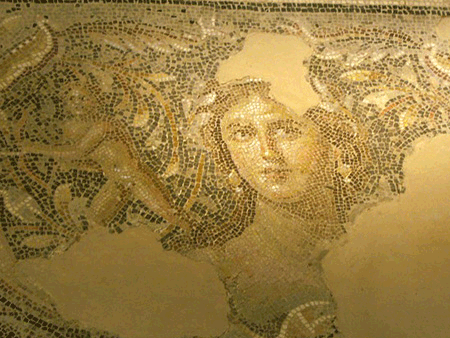 |
|
Photo: Mike
Clark |
|
“Mona Lisa of Sepphoris” |
| |
|
Come with me to Sepphoris and let
our eyes feast on the brilliant mosaics while we
contemplate the total triumph of monotheism over its
antithesis of hedonism and idolatry. |
|
Copyright 2006,
20015
Gila Yudkin. Permission needed for any reuse. |
|
|
|
Postscript Reader George Maguire wrote
in response to this 'highlight':
|
"Traditionally it is thought that
Joachim and Anna were the parents of Mary
and that they lived in Sepphoris. If
that were really the case, then there is a
good chance that Joseph did work on the
city as it was growing and perhaps even
met Mary on one of those 'work trips'.
Following the birth of Jesus,
Sepphoris would probably have been visited
as both a place for Joseph and Jesus to
practice their trade and to visit with
'grandparents'. I fully agree with
your thought that since it was only an
hour away and it was a city with lots of
work opportunities and with 'hypocrite' as
part of the language of Jesus, more likely
than not it was visited by Him as part of
his apprenticeship and to visit with his
bubbi." (Yiddish for
grandmother)
|
Lola Warren
from Williamsburg Virginia commented:
"The probability of Jesus' having
worked in Sepphoris is intriguing and
makes so much sense. Carpentry just
for the Nazarenes doesn't seem to me like
it was so much of a full-time profession.
Perhaps, with the opportunities in
Sepphoris, he was able to stash away some
profits, which allowed him to give it all
up and travel -- maybe even to the Far
East, as some think.
One could assume that being the elder
son of Joseph, Jesus went with Joseph to
work, wherever that might have been, and
interacted with customers, fellow
artisans, etc. from a very early age.
These interactions, in a place like
Sepphoris, could have opened the doors to
extensive theological/philosophical
discussions among people of a variety of
Middle Eastern persuasions, and
contributed to New Testament ideas that we
have been led to believe were
revolutionary.
Thanks for adding to my
brain-storming!"
|
|
More Galilee:
|
| |
|
|
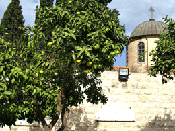 |
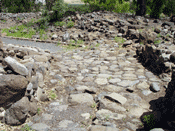 |
 |
|
Wedding in Cana
|
Bethsaida |
Hippos / Decapolis
city |
| |
|
|
 |
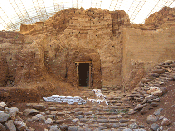 |
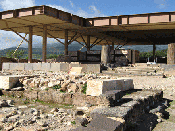 |
|
Mount of Beatitudes |
Dan and Abraham |
Hazor's Canaanite
palace |
|
|
|
|
Gila Yudkin,
who calls herself a Connecticut-born Yankee
living now in King David's Court, has been
guiding pilgrims in the Holy Land for a
quarter of a century. Most of all, she
enjoys showing "old-timers." new exciting
sites. It’s recommended to contact
Gila while you are planning your pilgrimage
to ensure that you allow enough time to see
all of Sepphoris’ highlights. |
| |
|
|
|
GILA
YUDKIN
•
TCHERNIKOVSKI
64A
•
JERUSALEM
•
ISRAEL
gila@itsgila.com
HOME
•
HOLY LAND
HEROINES
•
TIPS
FOR TOURS •
ABOUT GILA
|
|

